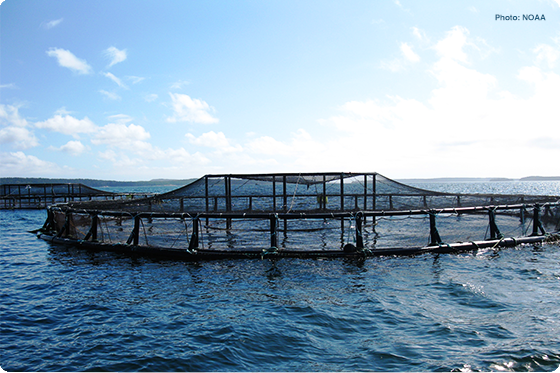Blog
- Home
- ▸
- Blog
- ▸
- October 2024
- ▸
- Don’t Cage Our Oceans: The Army Corps’ Nationwide Permit for Commercial Finfish Aquaculture Found to be Unlawful
-
Don’t Cage Our Oceans: The Army Corps’ Nationwide Permit for Commercial Finfish Aquaculture Found to be Unlawful
- October 24th, 2024 — by Ashlyn Tracy — Category: Aquaculture
- Tweet
-

In 2022, Don’t Cage Our Oceans and other nonprofit organizations groups (collectively “DCOO”) sued the United States Army Corps of Engineers (“Corps”) for its issuance of Nationwide Permit 56 (“NWP 56”), which authorized the installation of finfish aquaculture structures within oceans around the country.1 On September 30th, 2024, the Western District Court of Washington granted partial summary judgment in favor of DCOO, finding that while the Corps acted within its authority to issue NWP 56, they failed to fully comply with the Rivers and Harbors Act of 1899 (“RHA”) and the National Environmental Policy Act (“NEPA”)’s procedural requirements, violating the Administrative Procedures Act (“APA”).2 In making their decision, the court relied on 3 factors: (1) DCOO’s ability to bring this suit against the Corps, (2) whether the Corps had the authority to issue NWP 56, and (3) whether the Corps followed the environmental analysis (“EA”) procedural requirements.
First, the court found that DCOO had sufficiently met all requirements for bringing the lawsuit because (1) the Corps did not follow proper procedures when assessing NWP 56’s environmental impacts, (2) DCOO faced imminent harm due to the use of areas likely to be impacted by NWP 56, and (3) complying with proper procedures could have led to a different outcome.3
Second, the court found that the Corps had the authority to issue NWP 56 under the Outer Continental Shelf Lands Act (“OCSLA”) because neither OSCLA nor its legislative history supported DCOO’s argument that NWP 56 is outside of the Corps' authority, and their reading of OCSLA, as well as previous cases, indicated that the Corps has authority to install structures not just related to energy resources but also for exploring and producing other resources.4 Additionally, the court found NWP 56 does not unconstitutionally convey property rights as NWP 56 disclaims conveyance of any property rights and there was not any proof that every activity authorized under NWP 56 would require further property rights granted by Congress.5
Finally, the court found that the Corps failed to comply with RHA and NEPA procedural obligations, rendering NWP 56 unlawful. Under NEPA and Section 10 of the RHA, the Corps must analyze whether projects are suitable for nationwide authorization and consider all potential environmental impacts in an EA to determine whether the activities will only cause a minimal impact.6 In its analysis, the Corps acknowledged numerous potential adverse effects if NWP 56 was approved, but did not conduct a detailed analysis of operational activities because they claimed they could not control many of the adverse impacts identified, and ultimately concluded that NWP 56 will not have more than a minimal effect on the aquatic environment.7
Under the APA, the court may set aside action that is arbitrary, capricious, an abuse of discretion, or otherwise not in accordance with the law.8 Applying this standard, the court concluded that the impact analysis was inadequate because: (1) the potential effects of the structures are not within the Corps’ control, (2) the Corps may not distance itself from the direct environmental impacts that could result from the structures because the aquaculture activities themselves are not authorized by NWP 56, (3) the Corps did not explain how it found that there would be no more than minimal environmental impacts from the potential adverse effects, and (4) the future assessments or mitigation tactics the Corps required for NWP 56 did not satisfy their obligation to consider the cumulative effects.9 In sum, since the Corps narrowed its analysis only to disclosing the foreseeable effects of NWP 56, and did not account for these effects in the EA, their findings were insufficient.
Since that court determined that NWP 56 is unlawful, it is faced with the question of whether to fully vacate—remove—NWP 56 or leave it in place while the Corps revises it.10 The court found it had no basis to evaluate the extent of any disruptions that would occur if NWP 56 is vacated, so it ordered the parties to jointly propose a resolution by October 18th.11
1 Don’t Cage Our Oceans, et al. v. United States Army Corps of Engineers, et al., No. C22-1627-KKE, 2024 WL 4349548, at *1 (W.D. Wash. Sept. 30, 2024).
2 Id.
3 Id. at *3.
4 Id. at *12-13.
5 Id. at *12.
6 Id. at *4.
7 Id.
8 Id. at *4-5.
9 Id. at *8-10.
10 Id. at *13.
11 Id.
Stay Current with
Our Publications
Subscribe today to our free
quarterly publication, The SandBar
— and to our monthly newsletter,
the Ocean and Coastal Case Alert.
Blog Post Archive
2025
2024
2023
2022
2021
2020
2019
2018
Blog Post Categories
Admiralty Aquaculture
Clean Water Act
COVID-19
Coastal Management
Endangered Species
Environmental Justice
Environmental Law
Fisheries
Flooding
Groundwater
Hurricanes
Insurance
Invasive Species
Litigation Briefs
Marine Debris
Marine Monuments
Miscellaneous
Natural Disasters
Offshore Energy
OSHA
PPP
Seafood
Staff
Torts
Water Quality










